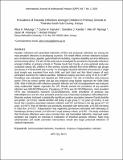Prevalence of Parasitic Infections amongst Children in Primary Schools in Tharaka South Sub County, Kenya

View/
Date
2019-05Author
Mutungi, Alice K.
Kariuki, Curtis H.
Kandie, Geredine J.
Njoroge, Alex W.
Anampiu, Jason M.
Kibebe, Herbert
Type
ArticleLanguage
enMetadata
Show full item recordAbstract
Parasitic infections-soil transmitted helminths (STHs) and protozoan infections are among the most prevalent infections in developing countries.Health effects of these infections include; poor nutritional status,appetite,gastrointestinal morbidity,cognitive disability and iron deficiency anemia among others.The aim of this study was to investigate the prevalence of parasitic infections amongst children in primary schools in Tharaka South Sub County.A cross-sectional study was conducted among 481 children in five primary schools selected from three different age groups and classes in the County.To investigate intestinal helminths and protozoa,a single stool sample was examined from each child,and both thick and thin blood smears of each participant examined for malaria parasites.Statistical analysis was done using STATA 13 MP®.Prevalence was calculated and reported per 1000 persons.The risk of infection with protozoa and/or STHs by school,gender and age was analyzed using logistic regression for Odds Ratio (OR). Risk of infection with infectious parasitic infection and risk of polyparasitism was analyzed using multivariate logistic regression for OR.Results showed the prevalence of any parasitic infection was 548.86/1000persons.Prevalence of STHs was 83.16/1000persons,most prevalent STHs was Schistosoma mansonii 33.26/1000persons,while prevalence of protozoa was 466/1000persons and the most prevalent protozoa was Entamoeba hystolytica 235/1000persons.Bivariate analysis indicated a statistically significant positive association between Giardia lamblia and gender, (p=0.014),Giardia lamblia and being in age group (7 -10 years (p=0.041),it was found that a positive association between infection with EC and being in the age group of 7-10 years, p=0.037).Risk of infection was positively associated with being male, p=0.029 and being in class five,p=0.017.Polyparasitism was negatively (protective) associated with belonging to Kamatungu primary school, p=0.029 and Tunyai primary school, p=0.007.The study concludes that Protozoan infections were more common than soil transmitted helminths.Improved water sanitation and hygiene are essential in eradication of intestinal parasitic infection.Mass drug administration and health promotion interventions should also target protozoal infections of medical importance.
URI
http://library.kemu.ac.ke/ijpp/index.php/ijpp/article/view/17http://repository.kemu.ac.ke:8080/xmlui/handle/123456789/327
Citation
Mutungi, A., Kariuki, C., Kandie, J., Njoroge, A., Anampiu, J., & Kibebe, H. (2019). Prevalence of Parasitic Infections amongst Children in Primary Schools in Tharaka South Sub County, Kenya. International Journal of Professional Practice, 7(1), 58-71. Retrieved from http://library.kemu.ac.ke/ijpp/index.php/ijpp/article/view/17Publisher
International Journal of professional practice (IJPP)
Description
http://library.kemu.ac.ke/ijpp/index.php/ijpp/article/view/17
Collections
- Articles [44]
- School of Medicine and Health Sciences [158]
